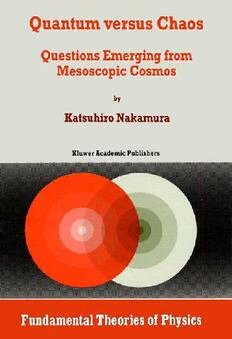
Quantum versus chaos: questions from mesoscopy PDF
Preview Quantum versus chaos: questions from mesoscopy
Quantum versus Chaos Fundamental Theories of Physics An International Book Series on The Fundamental Theories of Physics: Their Clarification, Development and Application Editor: ALWYN VAN DER MERWE University of Denver, U.S.A. Editorial Advisory Board: LAWRENCE P. HORWITZ, Tel-Aviv University, Israel BRIAN D. JOSEPHSON, University of Cambridge, U.K. CLIVE KILMISTER, University of London, U.K. PEKKA J. LAHTI, University of Turku, Finland GÜNTER LUDWIG, Philipps-Universität, Marburg, Germany ASHER PERES, Israel Institute of Technology, Israel NATHAN ROSEN, Israel Institute of Technology, Israel EDUARD PRUGOVECKI, University of Toronto, Canada MENDEL SACHS, State University of New York at Buffalo, U.S.A. ABDUS SALAM, International Centre for Theoretical Physics, Trieste, Italy HANS-JÜRGEN TREDER, Zentralinstitut für Astrophysik der Akademie der Wissenschafen, Germany Volume 87 Quantum versus Chaos Questions Emerging from Mesoscopic Cosmos by Katsuhiro Nakamura Faculty of Engineering, Osaka City University, Osaka, Japan KLUWER ACADEMIC PUBLISHERS NEW YORK / BOSTON / DORDRECHT / LONDON / MOSCOW eBookISBN: 0-306-47121-3 Print ISBN: 0-792-34557-6 ©2002 Kluwer Academic Publishers New York, Boston, Dordrecht, London, Moscow All rights reserved No part of this eBook may be reproduced or transmitted in any form or by any means, electronic, mechanical, recording, or otherwise, without written consent from the Publisher Created in the United States of America Visit Kluwer Online at: http://www.kluweronline.com and Kluwer's eBookstore at: http://www.ebooks.kluweronline.com Table of Contents Preface ix Chapter 1. Genesis of chaos and breakdown of quantization of adiabatic invariants 1 1.1. Introduction 1 1.2. Collapse of KAM tori and onset of chaos 2 1.3. Diagnostic characters of chaos 7 1.4. Suppression of chaos in quantum dynamics 9 1.5. Breakdown of quantization of adiabatic invariants 11 References 14 Chapter 2. Semiclassical quantization of chaos: trace formula 15 2.1. Green's function and Feynman's path integral method 15 2.2. Quantization of integrable systems 17 2.3. Quantization of chaos: trace formula 19 2.4. Application of trace formula to autocorrelation functions 22 2.5. Significance and limitation of trace formula 29 References 30 Chapter 3. Pseudo-chaos without classical counterpart in 1-dimensional quantum transport 31 3.1. Introduction 32 3.2. Quantum transport in superlattice and pseudo-chaos 32 3.3. Resonant tunneling in double-barrier structure and pseudo-chaos 39 3.4. General remarks 43 References 44 Chapter 4. Chaos and quantum transport in open magnetic billiards: from stadium to Sinai billiards 45 4.1. Introduction 46 V vi Table of Contents 4.2. Magneto-conductance in stadium billiard: experimental results 47 4.3. Transition from chaos to tori 50 4.4. Quantum-mechanical and semiclassical theories 54 4.5. Comparison in stadium billiards between theory and experiment 59 4.6. Open Sinai billiard in magnetic field: distribution of Lyapunov exponents and ghost orbits 66 4.7. Comparison in Sinai billiard between quantal and classical theories 70 4.8. Summary 75 References 76 Chapter 5. Chaotic scattering on hyperbolic billiards: success of semiclassical theory 79 5.1. Introduction 79 5.2. Exact quantum theory 83 5.3. Semiclassical theory 85 5.4. Distribution of complex resonances 92 5.5. Experiment on antidot arrays in magnetic field 97 References 100 Chapter 6. Nonadiabaticity-induced quantum chaos 102 6.1. Avoided level crossings and gauge structure 102 6.2. Nonadiabatic transitions and gauge structure 107 6.3. Forces induced by Born-Oppenheimer approximation 117 6.4. Nonadiabaticity-induced chaos 119 References 125 Chapter 7. Level dynamics and statistical mechanics 127 7.1. Level dynamics: from Brownian motion to generalized Calogero-Moser-Sutherland (gCM/gCS) system 127 7.2. Soliton turbulence: a new interpretation of irregular spectra 136 7.3. Statistical mechanics of gCM system 142 7.4. Statistical mechanics of gCS system in intermediate regime 151 7.5. Extension to case of several parameters 154 References 160 Table of Contents vii Chapter 8. Towards time-discrete quantum mechanics 162 8.1. Stable and unstable manifolds in time-discrete classical dynamics 162 8.2. Breakdown of perturbation theory 166 8.3. Internal equation and Stokes phenomenon 168 8.4. Asymptotic expansion beyond all orders and homoclinic structures 175 8.5. Time discretization and quantum dynamics 181 8.6. Time-discrete unitary quantum dynamics 183 8.7. Time-discrete non-unitary quantum dynamics 186 8.8. Problems to be examined 196 References 197 Chapter 9. Conclusions and prospects 198 References 207 Index 209 This page intentionally left blank. Preface The framework of quantum mechanics in the adiabatic limit where no quantum transition occurs is traced back to the quantization condition of adiabatic invariants, i.e., of action variables. In fact, the interpretation of this condition as the commutation rule for a pair of canonical variables led to the construction of Heisenberg's matrix equation; another interpretation of this condition, as that for confining a standing wave, led to the birth of Schröd inger's wave mechanics. In classically-chaotic systems, however, the stable tori are broken up and we can conceive no action to be quantized. Therefore, we cannot prevent ourselves from being suspicious of using the present formalism of quantum mechanics beyond the logically acceptable (i.e., classically- integrable) regime. Actually, quantum dynamics of classically-chaotic systems yields only quasi-periodic and recurrent behaviors, thereby losing the classical-quantum correspondence. There prevails a general belief in the incompatibility between quantum andchaos. Presumably, a generalized variant of quantum mechanics should be established so as to accommodate the temporal chaos. The range of validity of the present formalism of quantum mechanics will be elucidated by an accumulation of experiments on the mesoscopic or nanoscale cosmos. Owing to recent progress in advanced technology, nanoscale quantum dots such as chaotic stadium and integrable circle billiards have been fabricated at interfaces of semiconductor heterojunctions, and quantum transport in these systems is under active experimental investigation. Anomalous fluctuation properties as well as interesting fine spectral structures that have already been reported are indicating symptoms of chaos. Quantum transport in mesoscopic systems will serve as a nice candidate for elucidating the effectivenes and noneffectiveness of quantum mechanics when applied to classically-chaotic systems. The experimental results could even provide a clue towards the creation of a generalized quantum mechanics, just as blackbody cavity radiation at the turn of the last century did for the creation of present-day ix
